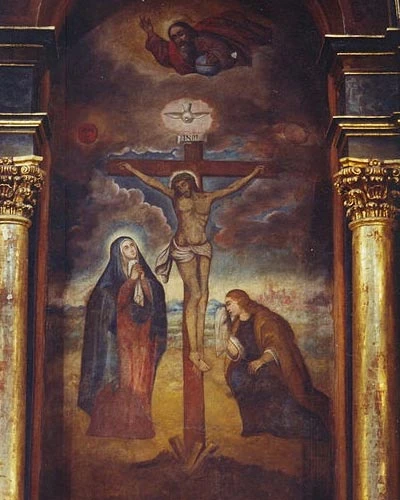More than 370 years ago a black slave painted the image of Jesus on a mud wall, which survived several earthquakes and is now venerated by millions of Catholics around the world.
The history of the Lord of Miracles, one of the most popular and appreciated devotions in Peru, dates back to the 17th century, when the population of the capital of the Viceroyalty of Peru, Lima, grew with the arrival of slaves from West Africa, who were classified by caste, among which were the Angolas.
Receive the main news from ACI Prensa by WhatsApp and Telegram
It is increasingly difficult to see Catholic news on social media. Subscribe to our free channels today:

Original painting of the Lord of Miracles / Credit: Public Domain
The latter raised their brotherhood in a warehouse in the Pachacamilla area, on the outskirts of what is today known as the historic center of Lima. In that place, an Angolan slave, whose name is believed to be Pedro Dalcón or Benito, painted the image of the crucified Christ on an adobe wall.
The image remained unknown to many of the inhabitants until November 13, 1655, when a terrible earthquake shook the city and left thousands of dead.
The seismic movement collapsed all the walls of the brotherhood’s shed, except the weak adobe wall with the image of Christ.
“Little was left standing: a section of the wall of the Christ of Pachacamilla remained miraculously intact, while, in its surroundings, desolation reigned,” indicates the Catholic Encyclopedia.
However, the image was abandoned again until 1671 when the resident of the parish of San Sebastián, Andrés de León, was moved when passing in front of the wall and decided to take care of it. That same year, this devotee prayed to the Lord for the healing of a tumor and the miracle was granted to him. This fact spread throughout the city and more and more people came to pray in front of the brown Christ.
The Catholic Encyclopedia reports that civil and religious authorities decided to eliminate the image because they considered this type of devotion inappropriate. However, the people who tried to erase it gave up doing so due to the supernatural events they experienced.
“The painter tried it twice: the first time he fainted, and the second time he was paralyzed. Then, another person, who also wanted to try it, suffered from an unusual tremor. Finally, a person different from the previous ones, who was offered payment, said he couldn’t do it,” he added.
Viceroy Pedro Antonio Fernández de Castro, also known as the Count of Lemos, reached an agreement with the ecclesiastical authorities so that the painting would be venerated in its original place and a provisional hermitage would be built.
Thus, the Catholic Encyclopedia states that “on September 14, 1671, the day of the Feast of the exaltation of the Crossthe first was held Misa in front of the prodigious wall. By that date the images of the Virgin and Saint Mary Magdalene had already been added.”
Years later, images of God the Father and the Holy Spirit were added, completing the Calvary scene.
The Lord of Miracles resisted other earthquakes, such as the one that destroyed the city of Lima on October 20, 1687 and that inspired the fourth mayordomo, Sebastián de Antuñano y Rivas, to carry out the first procession of the image.
In 1746 another earthquake occurred, considered the strongest in the history of Lima and which left the capital and the port of Callao devastated.
“The earthquake of 1746 did not knock down the wall either, although it left the capital in ruins. With this, the faith in Cristo Moreno was cemented,” explained the general mayor of the Brotherhood of the Lord of Miracles of Nazarenas, Manuel Orrillo, to The Commerce.
Gradually, devotion to Cristo Moreno expanded and currently hundreds of thousands of people come to the Sanctuary of the Nazarenes —on whose altar is the original image—, especially in October to take out a replica of the image in procession.
The Lord of Miracles also walks the streets in other countries in America and Europe, such as Chile, Colombia, Argentina, the United States, Italy and France, where brotherhoods organize processions.
Due to the coronavirus pandemic, in 2020 and 2021, the Lord of Miracles did not go out in procession, a fact that had not happened since the War of the Pacific, more than 110 years ago, which pitted Peru and Chile against each other. In 2022, the processions resumed.
If you want to learn more about this devotion click HERE.

